前言:
CNN作為DL中最成功的模型之一,有必要對其更進一步研究它。雖然在前面的博文Stacked CNN簡單介紹中有大概介紹過CNN的使用,不過那是有個前提的:CNN中的引數必須已提前學習好。而本文的主要目的是介紹CNN引數在使用bp演算法時該怎麼訓練,畢竟CNN中有卷積層和下采樣層,雖然和MLP的bp演算法本質上相同,但形式上還是有些區別的,很顯然在完成CNN反向傳播前瞭解bp演算法是必須的。本文的實驗部分是參考史丹佛UFLDL新教程UFLDL:Exercise: Convolutional Neural Network裡面的內容。完成的是對MNIST數字的識別,採用有監督的CNN網路,當然了,實驗很多引數結構都按照教程上給的,這裡並沒有去調整。
實驗基礎:
CNN反向傳播求導時的具體過程可以參考論文Notes on Convolutional Neural Networks, Jake Bouvrie,該論文講得很全面,比如它考慮了pooling層也加入了權值、偏置值及非線性激發(因為這2種值也需要learn),對該論文的解讀可參考zouxy09的博文CNN卷積神經網路推導和實現。除了bp演算法外,本人認為理解了下面4個子問題,基本上就可以弄懂CNN的求導了(bp演算法這裡就不多做介紹,網上資料實在是太多了),另外為了講清楚一些細節過程,本文中舉的例子都是簡化了一些條件的,且linux下文字和公式編輯太難弄了,文中難免有些地方會出錯,大家原諒下。
首先我們來看看CNN系統的目標函式,設有樣本(xi, yi)共m個,CNN網路共有L層,中間包含若干個卷積層和pooling層,最後一層的輸出為f(xi),則系統的loss表示式為(對權值進行了懲罰,一般分類都採用交叉熵形式):

問題一:求輸出層的誤差敏感項。
現在只考慮個一個輸入樣本(x, y)的情形,loss函式和上面的公式類似是用交叉熵來表示的,暫時不考慮權值規則項,樣本標籤採用one-hot編碼,CNN網路的最後一層採用softmax全連線(多分類時輸出層一般用softmax),樣本(x,y)經過CNN網路後的最終的輸出用f(x)表示,則對應該樣本的loss值為:

其中f(x)的下標c的含義見公式:

因為x通過CNN後得到的輸出f(x)是一個向量,該向量的元素值都是概率值,分別代表著x被分到各個類中的概率,而f(x)中下標c的意思就是輸出向量中取對應c那個類的概率值。
採用上面的符號,可以求得此時loss值對輸出層的誤差敏感性表示式為:

其中e(y)表示的是樣本x標籤值的one-hot表示,其中只有一個元素為1,其它都為0.
其推導過程如下(先求出對輸出層某個節點c的誤差敏感性,參考Larochelle關於DL的課件:Output layer gradient),求出輸出層中c節點的誤差敏感值:

由上面公式可知,如果輸出層採用sfotmax,且loss用交叉熵形式,則最後一層的誤差敏感值就等於CNN網路輸出值f(x)減樣本標籤值e(y),即f(x)-e(y),其形式非常簡單,這個公式是不是很眼熟?很多情況下如果model採用MSE的loss,即loss=1/2*(e(y)-f(x))^2,那麼loss對最終的輸出f(x)求導時其結果就是f(x)-e(y),雖然和上面的結果一樣,但是大家不要搞混淆了,這2個含義是不同的,一個是對輸出層節點輸入值的導數(softmax激發函式),一個是對輸出層節點輸出值的導數(任意激發函式)。而在使用MSE的loss表示式時,輸出層的誤差敏感項為(f(x)-e(y)).*f(x)’,兩者只相差一個因子。
這樣就可以求出第L層的權值W的偏導數:

輸出層偏置的偏導數:

上面2個公式的e(y)和f(x)是一個矩陣,已經把所有m個訓練樣本考慮進去了,每一列代表一個樣本。
問題二:當接在卷積層的下一層為pooling層時,求卷積層的誤差敏感項。
假設第l(小寫的l,不要看成數字’1’了)層為卷積層,第l+1層為pooling層,且pooling層的誤差敏感項為: ![]() ,卷積層的誤差敏感項為:
,卷積層的誤差敏感項為:![]() , 則兩者的關係表示式為:
, 則兩者的關係表示式為:

這裡符號●表示的是矩陣的點積操作,即對應元素的乘積。卷積層和unsample()後的pooling層節點是一一對應的,所以下標都是用j表示。後面的符號![]() 表示的是第l層第j個節點處激發函式的導數(對節點輸入的導數)。
表示的是第l層第j個節點處激發函式的導數(對節點輸入的導數)。
其中的函式unsample()為上取樣過程,其具體的操作得看是採用的什麼pooling方法了。但unsample的大概思想為:pooling層的每個節點是由卷積層中多個節點(一般為一個矩形區域)共同計算得到,所以pooling層每個節點的誤差敏感值也是由卷積層中多個節點的誤差敏感值共同產生的,只需滿足兩層見各自的誤差敏感值相等,下面以mean-pooling和max-pooling為例來說明。
假設卷積層的矩形大小為4×4, pooling區域大小為2×2, 很容易知道pooling後得到的矩形大小也為2*2(本文預設pooling過程是沒有重疊的,卷積過程是每次移動一個畫素,即是有重疊的,後續不再宣告),如果此時pooling後的矩形誤差敏感值如下:

則按照mean-pooling,首先得到的卷積層應該是4×4大小,其值分佈為(等值複製):
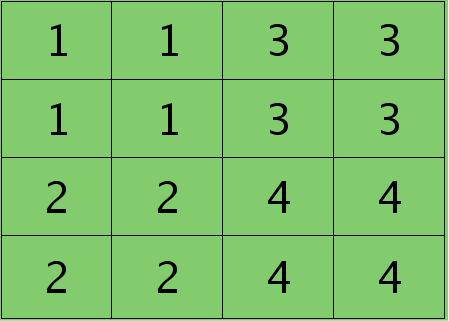
因為得滿足反向傳播時各層間誤差敏感總和不變,所以卷積層對應每個值需要平攤(除以pooling區域大小即可,這裡pooling層大小為2×2=4)),最後的卷積層值
分佈為:
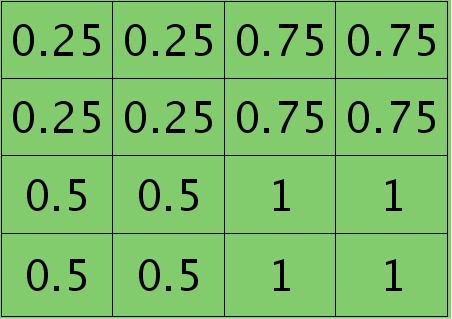
mean-pooling時的unsample操作可以使用matalb中的函式kron()來實現,因為是採用的矩陣Kronecker乘積。C=kron(A, B)表示的是矩陣B分別與矩陣A中每個元素相乘,然後將相乘的結果放在C中對應的位置。比如:

如果是max-pooling,則需要記錄前向傳播過程中pooling區域中最大值的位置,這裡假設pooling層值1,3,2,4對應的pooling區域位置分別為右下、右上、左上、左下。則此時對應卷積層誤差敏感值分佈為:
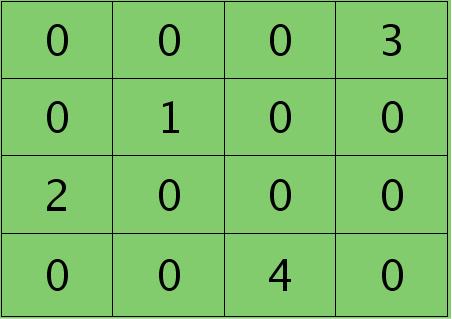
當然了,上面2種結果還需要點乘卷積層激發函式對應位置的導數值了,這裡省略掉。
問題三:當接在pooling層的下一層為卷積層時,求該pooling層的誤差敏感項。
假設第l層(pooling層)有N個通道,即有N張特徵圖,第l+1層(卷積層)有M個特徵,l層中每個通道圖都對應有自己的誤差敏感值,其計算依據為第l+1層所有特徵核的貢獻之和。下面是第l+1層中第j個核對第l層第i個通道的誤差敏感值計算方法:

符號★表示的是矩陣的卷積操作,這是真正意義上的離散卷積,不同於卷積層前向傳播時的相關操作,因為嚴格意義上來講,卷積神經網路中的卷積操作本質是一個相關操作,並不是卷積操作,只不過它可以用卷積的方法去實現才這樣叫。而求第i個通道的誤差敏感項時需要將l+1層的所有核都計算一遍,然後求和。另外因為這裡預設pooling層是線性激發函式,所以後面沒有乘相應節點的導數。
舉個簡單的例子,假設拿出第l層某個通道圖,大小為3×3,第l+1層有2個特徵核,核大小為2×2,則在前向傳播卷積時第l+1層會有2個大小為2×2的卷積圖。如果2個特徵核分別為:


反向傳播求誤差敏感項時,假設已經知道第l+1層2個卷積圖的誤差敏感值:
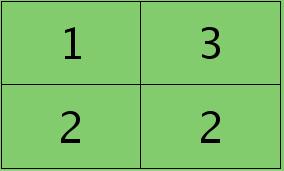
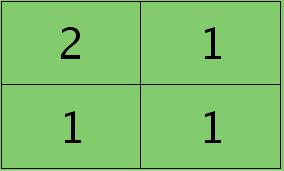
離散卷積函式conv2()的實現相關子操作時需先將核旋轉180度(即左右翻轉後上下翻轉),但這裡實現的是嚴格意義上的卷積,所以在用conv2()時,對應的引數核不需要翻轉(在有些toolbox裡面,求這個問題時用了旋轉,那是因為它們已經把所有的卷積核都旋轉過,這樣在前向傳播時的相關操作就不用旋轉了。並不矛盾)。且這時候該函式需要採用’full’模式,所以最終得到的矩陣大小為3×3,(其中3=2+2-1),剛好符第l層通道圖的大小。採用’full’模式需先將第l+1層2個卷積圖擴充,周圍填0,padding後如下:
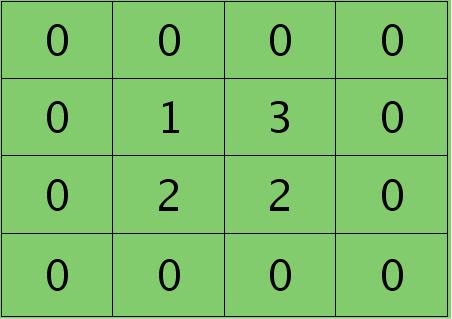
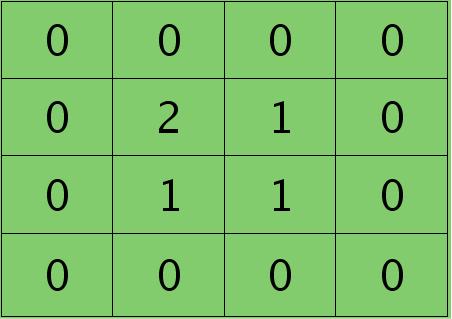
擴充後的矩陣和對應的核進行卷積的結果如下情況:


可以通過手動去驗證上面的結果,因為是離散卷積操作,而離散卷積等價於將核旋轉後再進行相關操作。而第l層那個通道的誤差敏感項為上面2者的和,呼應問題三,最終答案為:
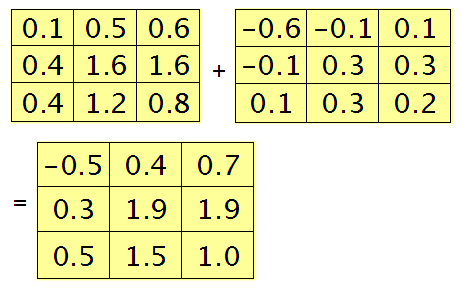
那麼這樣問題3這樣解的依據是什麼呢?其實很簡單,本質上還是bp演算法,即第l層的誤差敏感值等於第l+1層的誤差敏感值乘以兩者之間的權值,只不過這裡由於是用了卷積,且是有重疊的,l層中某個點會對l+1層中的多個點有影響。比如說最終的結果矩陣中最中間那個0.3是怎麼來的呢?在用2×2的核對3×3的輸入矩陣進行卷積時,一共進行了4次移動,而3×3矩陣最中間那個值在4次移動中均對輸出結果有影響,且4次的影響分別在右下角、左下角、右上角、左上角。所以它的值為2×0.2+1×0.1+1×0.1-1×0.3=0.3, 建議大家用筆去算一下,那樣就可以明白為什麼這裡可以採用帶’full’型別的conv2()實現。
問題四:求與卷積層相連那層的權值、偏置值導數。
前面3個問題分別求得了輸出層的誤差敏感值、從pooling層推斷出卷積層的誤差敏感值、從卷積層推斷出pooling層的誤差敏感值。下面需要利用這些誤差敏感值模型中引數的導數。這裡沒有考慮pooling層的非線性激發,因此pooling層前面是沒有權值的,也就沒有所謂的權值的導數了。現在將主要精力放在卷積層前面權值的求導上(也就是問題四)。
假設現在需要求第l層的第i個通道,與第l+1層的第j個通道之間的權值和偏置的導數,則計算公式如下:
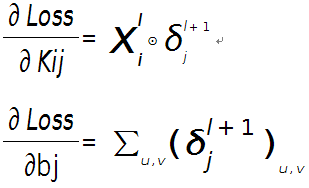
其中符號⊙表示矩陣的相關操作,可以採用conv2()函式實現。在使用該函式時,需將第l+1層第j個誤差敏感值翻轉。
例如,如果第l層某個通道矩陣i大小為4×4,如下:

第l+1層第j個特徵的誤差敏感值矩陣大小為3×3,如下:

很明顯,這時候的特徵Kij導數的大小為2×2的,且其結果為:

而此時偏置值bj的導數為1.2 ,將j區域的誤差敏感值相加即可(0.8+0.1-0.6+0.3+0.5+0.7-0.4-0.2=1.2),因為b對j中的每個節點都有貢獻,按照多項式的求導規則(和的導數等於導數的和)很容易得到。
為什麼採用矩陣的相關操作就可以實現這個功能呢?由bp演算法可知,l層i和l+1層j之間的權值等於l+1層j處誤差敏感值乘以l層i處的輸入,而j中某個節點因為是由i+1中一個區域與權值卷積後所得,所以j處該節點的誤差敏感值對權值中所有元素都有貢獻,由此可見,將j中每個元素對權值的貢獻(尺寸和核大小相同)相加,就得到了權值的偏導數了(這個例子的結果是由9個2×2大小的矩陣之和),同樣,如果大家動筆去推算一下,就會明白這時候為什麼可以用帶’valid’的conv2()完成此功能。
實驗總結:
- 卷積層過後,可以先跟pooling層,再通過非線性傳播函式。也可以是先通過非線性傳播函式再經過pooling層。
- CNN的結構本身就是一種規則項。
- 實際上每個權值的學習率不同時優化會更好。
- 發現Ng以前的ufldl中教程裡面softmax並沒有包含偏置值引數,至少他給的start code裡面沒有包含,嚴格來說是錯誤的。
- 當輸入樣本為多個時,bp演算法中的誤差敏感性也是一個矩陣。每一個樣本都對應有自己每層的誤差敏感性。
- 血的教訓啊,以後迴圈變數名不能與終止名太相似,一不小心引用下標是就弄錯,比如for filterNum = 1:numFilters 時一不小心把下標用numFilters去代替了,花了大半天去查這個debug.
7. matlab中conv2()函式在卷積過程中預設是每次移動一個畫素,即重疊度最高的卷積。
實驗結果:
按照網頁教程UFLDL:Exercise: Convolutional Neural Network和UFLDL:Optimization: Stochastic Gradient Descent,對MNIST資料庫進行識別,完成練習中YOU CODE HERE部分後,該CNN網路的識別率為:
95.76%
只採用了一個卷積層+一個pooling層+一個softmax層。卷積層的特徵個數為20,卷積核大小為9×9, pooling區域大小為2×2.
在進行實驗前,需下載好本實驗的標準程式碼:https://github.com/amaas/stanford_dl_ex。
然後在common資料夾放入下載好的MNIST資料庫,見http://yann.lecun.com/exdb/mnist/.注意MNIST檔名需要和程式碼中的保持一致。
實驗程式碼:
cnnTrain.m:
%% Convolution Neural Network Exercise % Instructions % ------------ % % This file contains code that helps you get started in building a single. % layer convolutional nerual network. In this exercise, you will only % need to modify cnnCost.m and cnnminFuncSGD.m. You will not need to % modify this file. %%====================================================================== %% STEP 0: Initialize Parameters and Load Data % Here we initialize some parameters used for the exercise. % Configuration imageDim = 28; numClasses = 10; % Number of classes (MNIST images fall into 10 classes) filterDim = 9; % Filter size for conv layer,9*9 numFilters = 20; % Number of filters for conv layer poolDim = 2; % Pooling dimension, (should divide imageDim-filterDim+1) % Load MNIST Train addpath ./common/; images = loadMNISTImages('./common/train-images-idx3-ubyte'); images = reshape(images,imageDim,imageDim,[]); labels = loadMNISTLabels('./common/train-labels-idx1-ubyte'); labels(labels==0) = 10; % Remap 0 to 10 % Initialize Parameters,theta=(2165,1),2165=9*9*20+20+100*20*10+10 theta = cnnInitParams(imageDim,filterDim,numFilters,poolDim,numClasses); %%====================================================================== %% STEP 1: Implement convNet Objective % Implement the function cnnCost.m. %%====================================================================== %% STEP 2: Gradient Check % Use the file computeNumericalGradient.m to check the gradient % calculation for your cnnCost.m function. You may need to add the % appropriate path or copy the file to this directory. DEBUG=false; % set this to true to check gradient %DEBUG = true; if DEBUG % To speed up gradient checking, we will use a reduced network and % a debugging data set db_numFilters = 2; db_filterDim = 9; db_poolDim = 5; db_images = images(:,:,1:10); db_labels = labels(1:10); db_theta = cnnInitParams(imageDim,db_filterDim,db_numFilters,... db_poolDim,numClasses); [cost grad] = cnnCost(db_theta,db_images,db_labels,numClasses,... db_filterDim,db_numFilters,db_poolDim); % Check gradients numGrad = computeNumericalGradient( @(x) cnnCost(x,db_images,... db_labels,numClasses,db_filterDim,... db_numFilters,db_poolDim), db_theta); % Use this to visually compare the gradients side by side disp([numGrad grad]); diff = norm(numGrad-grad)/norm(numGrad+grad); % Should be small. In our implementation, these values are usually % less than 1e-9. disp(diff); assert(diff < 1e-9,... 'Difference too large. Check your gradient computation again'); end; %%====================================================================== %% STEP 3: Learn Parameters % Implement minFuncSGD.m, then train the model. % 因為是採用的mini-batch梯度下降法,所以總共對樣本的迴圈次數次數比標準梯度下降法要少 % 很多,因為每次迴圈中權值已經迭代多次了 options.epochs = 3; options.minibatch = 256; options.alpha = 1e-1; options.momentum = .95; opttheta = minFuncSGD(@(x,y,z) cnnCost(x,y,z,numClasses,filterDim,... numFilters,poolDim),theta,images,labels,options); save('theta.mat','opttheta'); %%====================================================================== %% STEP 4: Test % Test the performance of the trained model using the MNIST test set. Your % accuracy should be above 97% after 3 epochs of training testImages = loadMNISTImages('./common/t10k-images-idx3-ubyte'); testImages = reshape(testImages,imageDim,imageDim,[]); testLabels = loadMNISTLabels('./common/t10k-labels-idx1-ubyte'); testLabels(testLabels==0) = 10; % Remap 0 to 10 [~,cost,preds]=cnnCost(opttheta,testImages,testLabels,numClasses,... filterDim,numFilters,poolDim,true); acc = sum(preds==testLabels)/length(preds); % Accuracy should be around 97.4% after 3 epochs fprintf('Accuracy is %f\n',acc);
cnnConvolve.m:
function convolvedFeatures = cnnConvolve(filterDim, numFilters, images, W, b) %cnnConvolve Returns the convolution of the features given by W and b with %the given images % % Parameters: % filterDim - filter (feature) dimension % numFilters - number of feature maps % images - large images to convolve with, matrix in the form % images(r, c, image number) % W, b - W, b for features from the sparse autoencoder,傳進來的w已經是矩陣的形式 % W is of shape (filterDim,filterDim,numFilters) % b is of shape (numFilters,1) % % Returns: % convolvedFeatures - matrix of convolved features in the form % convolvedFeatures(imageRow, imageCol, featureNum, imageNum) numImages = size(images, 3); imageDim = size(images, 1); convDim = imageDim - filterDim + 1; convolvedFeatures = zeros(convDim, convDim, numFilters, numImages); % Instructions: % Convolve every filter with every image here to produce the % (imageDim - filterDim + 1) x (imageDim - filterDim + 1) x numFeatures x numImages % matrix convolvedFeatures, such that % convolvedFeatures(imageRow, imageCol, featureNum, imageNum) is the % value of the convolved featureNum feature for the imageNum image over % the region (imageRow, imageCol) to (imageRow + filterDim - 1, imageCol + filterDim - 1) % % Expected running times: % Convolving with 100 images should take less than 30 seconds % Convolving with 5000 images should take around 2 minutes % (So to save time when testing, you should convolve with less images, as % described earlier) for imageNum = 1:numImages for filterNum = 1:numFilters % convolution of image with feature matrix convolvedImage = zeros(convDim, convDim); % Obtain the feature (filterDim x filterDim) needed during the convolution %%% YOUR CODE HERE %%% filter = W(:,:,filterNum); bc = b(filterNum); % Flip the feature matrix because of the definition of convolution, as explained later filter = rot90(squeeze(filter),2); % Obtain the image im = squeeze(images(:, :, imageNum)); % Convolve "filter" with "im", adding the result to convolvedImage % be sure to do a 'valid' convolution %%% YOUR CODE HERE %%% convolvedImage = conv2(im, filter, 'valid'); % Add the bias unit % Then, apply the sigmoid function to get the hidden activation %%% YOUR CODE HERE %%% convolvedImage = sigmoid(convolvedImage+bc); convolvedFeatures(:, :, filterNum, imageNum) = convolvedImage; end end end function sigm = sigmoid(x) sigm = 1./(1+exp(-x)); end
cnnPool.m:
function pooledFeatures = cnnPool(poolDim, convolvedFeatures) %cnnPool Pools the given convolved features % % Parameters: % poolDim - dimension of pooling region % convolvedFeatures - convolved features to pool (as given by cnnConvolve) % convolvedFeatures(imageRow, imageCol, featureNum, imageNum) % % Returns: % pooledFeatures - matrix of pooled features in the form % pooledFeatures(poolRow, poolCol, featureNum, imageNum) % numImages = size(convolvedFeatures, 4); numFilters = size(convolvedFeatures, 3); convolvedDim = size(convolvedFeatures, 1); pooledFeatures = zeros(convolvedDim / poolDim, ... convolvedDim / poolDim, numFilters, numImages); % Instructions: % Now pool the convolved features in regions of poolDim x poolDim, % to obtain the % (convolvedDim/poolDim) x (convolvedDim/poolDim) x numFeatures x numImages % matrix pooledFeatures, such that % pooledFeatures(poolRow, poolCol, featureNum, imageNum) is the % value of the featureNum feature for the imageNum image pooled over the % corresponding (poolRow, poolCol) pooling region. % % Use mean pooling here. %%% YOUR CODE HERE %%% % convolvedFeatures(imageRow, imageCol, featureNum, imageNum) % pooledFeatures(poolRow, poolCol, featureNum, imageNum) for numImage = 1:numImages for numFeature = 1:numFilters for poolRow = 1:convolvedDim / poolDim offsetRow = 1+(poolRow-1)*poolDim; for poolCol = 1:convolvedDim / poolDim offsetCol = 1+(poolCol-1)*poolDim; patch = convolvedFeatures(offsetRow:offsetRow+poolDim-1, ... offsetCol:offsetCol+poolDim-1,numFeature,numImage); %取出一個patch pooledFeatures(poolRow,poolCol,numFeature,numImage) = mean(patch(:)); end end end end end
cnnCost.m:
function [cost, grad, preds] = cnnCost(theta,images,labels,numClasses,... filterDim,numFilters,poolDim,pred) % Calcualte cost and gradient for a single layer convolutional % neural network followed by a softmax layer with cross entropy % objective. % % Parameters: % theta - unrolled parameter vector % images - stores images in imageDim x imageDim x numImges % array % numClasses - number of classes to predict % filterDim - dimension of convolutional filter % numFilters - number of convolutional filters % poolDim - dimension of pooling area % pred - boolean only forward propagate and return % predictions % % % Returns: % cost - cross entropy cost % grad - gradient with respect to theta (if pred==False) % preds - list of predictions for each example (if pred==True) if ~exist('pred','var') pred = false; end; imageDim = size(images,1); % height/width of image numImages = size(images,3); % number of images lambda = 3e-3; % weight decay parameter %% Reshape parameters and setup gradient matrices % Wc is filterDim x filterDim x numFilters parameter matrix % bc is the corresponding bias % Wd is numClasses x hiddenSize parameter matrix where hiddenSize % is the number of output units from the convolutional layer % bd is corresponding bias [Wc, Wd, bc, bd] = cnnParamsToStack(theta,imageDim,filterDim,numFilters,... poolDim,numClasses); %the theta vector cosists wc,wd,bc,bd in order % Same sizes as Wc,Wd,bc,bd. Used to hold gradient w.r.t above params. Wc_grad = zeros(size(Wc)); Wd_grad = zeros(size(Wd)); bc_grad = zeros(size(bc)); bd_grad = zeros(size(bd)); %%====================================================================== %% STEP 1a: Forward Propagation % In this step you will forward propagate the input through the % convolutional and subsampling (mean pooling) layers. You will then use % the responses from the convolution and pooling layer as the input to a % standard softmax layer. %% Convolutional Layer % For each image and each filter, convolve the image with the filter, add % the bias and apply the sigmoid nonlinearity. Then subsample the % convolved activations with mean pooling. Store the results of the % convolution in activations and the results of the pooling in % activationsPooled. You will need to save the convolved activations for % backpropagation. convDim = imageDim-filterDim+1; % dimension of convolved output outputDim = (convDim)/poolDim; % dimension of subsampled output % convDim x convDim x numFilters x numImages tensor for storing activations activations = zeros(convDim,convDim,numFilters,numImages); % outputDim x outputDim x numFilters x numImages tensor for storing % subsampled activations activationsPooled = zeros(outputDim,outputDim,numFilters,numImages); %%% YOUR CODE HERE %%% convolvedFeatures = cnnConvolve(filterDim, numFilters, images, Wc, bc); %前向傳播,已經經過了激發函式 activationsPooled = cnnPool(poolDim, convolvedFeatures); % Reshape activations into 2-d matrix, hiddenSize x numImages, % for Softmax layer activationsPooled = reshape(activationsPooled,[],numImages); %% Softmax Layer % Forward propagate the pooled activations calculated above into a % standard softmax layer. For your convenience we have reshaped % activationPooled into a hiddenSize x numImages matrix. Store the % results in probs. % numClasses x numImages for storing probability that each image belongs to % each class. probs = zeros(numClasses,numImages); %%% YOUR CODE HERE %%% %Wd=(numClasses,hiddenSize),probs的每一列代表一個輸出 M = Wd*activationsPooled+repmat(bd,[1,numImages]); M = bsxfun(@minus,M,max(M,[],1)); M = exp(M); probs = bsxfun(@rdivide, M, sum(M)); %why rdivide? %%====================================================================== %% STEP 1b: Calculate Cost % In this step you will use the labels given as input and the probs % calculate above to evaluate the cross entropy objective. Store your % results in cost. cost = 0; % save objective into cost %%% YOUR CODE HERE %%% % cost = -1/numImages*labels(:)'*log(probs(:)); % 首先需要把labels弄成one-hot編碼 groundTruth = full(sparse(labels, 1:numImages, 1)); cost = -1./numImages*groundTruth(:)'*log(probs(:))+(lambda/2.)*(sum(Wd(:).^2)+sum(Wc(:).^2)); %加入一個懲罰項 % cost = -1./numImages*groundTruth(:)'*log(probs(:)); % Makes predictions given probs and returns without backproagating errors. if pred [~,preds] = max(probs,[],1); preds = preds'; grad = 0; return; end; %% 將c步和d步合成在一起了 %====================================================================== % STEP 1c: Backpropagation % Backpropagate errors through the softmax and convolutional/subsampling % layers. Store the errors for the next step to calculate the gradient. % Backpropagating the error w.r.t the softmax layer is as usual. To % backpropagate through the pooling layer, you will need to upsample the % error with respect to the pooling layer for each filter and each image. % Use the kron function and a matrix of ones to do this upsampling % quickly. % STEP 1d: Gradient Calculation % After backpropagating the errors above, we can use them to calculate the % gradient with respect to all the parameters. The gradient w.r.t the % softmax layer is calculated as usual. To calculate the gradient w.r.t. % a filter in the convolutional layer, convolve the backpropagated error % for that filter with each image and aggregate over images. %%% YOUR CODE HERE %%% %%% YOUR CODE HERE %%% % 網路結構: images--> convolvedFeatures--> activationsPooled--> probs % Wd = (numClasses,hiddenSize) % bd = (hiddenSize,1) % Wc = (filterDim,filterDim,numFilters) % bc = (numFilters,1) % activationsPooled = zeros(outputDim,outputDim,numFilters,numImages); % convolvedFeatures = (convDim,convDim,numFilters,numImages) % images(imageDim,imageDim,numImges) delta_d = -(groundTruth-probs); % softmax layer's preactivation,每一個樣本都對應有自己每層的誤差敏感性。 Wd_grad = (1./numImages)*delta_d*activationsPooled'+lambda*Wd; bd_grad = (1./numImages)*sum(delta_d,2); %注意這裡是要求和 delta_s = Wd'*delta_d; %the pooling/sample layer's preactivation delta_s = reshape(delta_s,outputDim,outputDim,numFilters,numImages); %進行unsampling操作,由於kron函式只能對二維矩陣操作,所以還得分開弄 %delta_c = convolvedFeatures.*(1-convolvedFeatures).*(1./poolDim^2)*kron(delta_s, ones(poolDim)); delta_c = zeros(convDim,convDim,numFilters,numImages); for i=1:numImages for j=1:numFilters delta_c(:,:,j,i) = (1./poolDim^2)*kron(squeeze(delta_s(:,:,j,i)), ones(poolDim)); end end delta_c = convolvedFeatures.*(1-convolvedFeatures).*delta_c; % Wc_grad = convn(images,rot90(delta_c,2,'valid'))+ lambda*Wc; for i=1:numFilters Wc_i = zeros(filterDim,filterDim); for j=1:numImages Wc_i = Wc_i+conv2(squeeze(images(:,:,j)),rot90(squeeze(delta_c(:,:,i,j)),2),'valid'); end % Wc_i = convn(images,rot180(squeeze(delta_c(:,:,i,:))),'valid'); % add penalize Wc_grad(:,:,i) = (1./numImages)*Wc_i+lambda*Wc(:,:,i); bc_i = delta_c(:,:,i,:); bc_i = bc_i(:); bc_grad(i) = sum(bc_i)/numImages; end %% Unroll gradient into grad vector for minFunc grad = [Wc_grad(:) ; Wd_grad(:) ; bc_grad(:) ; bd_grad(:)]; end function X = rot180(X) X = flipdim(flipdim(X, 1), 2); end
minFuncSGD.m:
function [opttheta] = minFuncSGD(funObj,theta,data,labels,... options) % Runs stochastic gradient descent with momentum to optimize the % parameters for the given objective. % % Parameters: % funObj - function handle which accepts as input theta, % data, labels and returns cost and gradient w.r.t % to theta. % theta - unrolled parameter vector % data - stores data in m x n x numExamples tensor % labels - corresponding labels in numExamples x 1 vector % options - struct to store specific options for optimization % % Returns: % opttheta - optimized parameter vector % % Options (* required) % epochs* - number of epochs through data % alpha* - initial learning rate % minibatch* - size of minibatch % momentum - momentum constant, defualts to 0.9 %%====================================================================== %% Setup assert(all(isfield(options,{'epochs','alpha','minibatch'})),... 'Some options not defined'); if ~isfield(options,'momentum') options.momentum = 0.9; end; epochs = options.epochs; alpha = options.alpha; minibatch = options.minibatch; m = length(labels); % training set size % Setup for momentum mom = 0.5; momIncrease = 20; velocity = zeros(size(theta)); %%====================================================================== %% SGD loop it = 0; for e = 1:epochs % randomly permute indices of data for quick minibatch sampling rp = randperm(m); for s=1:minibatch:(m-minibatch+1) it = it + 1; % increase momentum after momIncrease iterations if it == momIncrease mom = options.momentum; end; % get next randomly selected minibatch mb_data = data(:,:,rp(s:s+minibatch-1)); % 取出當前的mini-batch的訓練樣本 mb_labels = labels(rp(s:s+minibatch-1)); % evaluate the objective function on the next minibatch [cost grad] = funObj(theta,mb_data,mb_labels); % Instructions: Add in the weighted velocity vector to the % gradient evaluated above scaled by the learning rate. % Then update the current weights theta according to the % sgd update rule %%% YOUR CODE HERE %%% velocity = mom*velocity+alpha*grad; % 見ufldl教程Optimization: Stochastic Gradient Descent theta = theta-velocity; fprintf('Epoch %d: Cost on iteration %d is %f\n',e,it,cost); end; % aneal learning rate by factor of two after each epoch alpha = alpha/2.0; end; opttheta = theta; end
computeNumericalGradient.m:
function numgrad = computeNumericalGradient(J, theta) % numgrad = computeNumericalGradient(J, theta) % theta: a vector of parameters % J: a function that outputs a real-number. Calling y = J(theta) will return the % function value at theta. % Initialize numgrad with zeros numgrad = zeros(size(theta)); %% ---------- YOUR CODE HERE -------------------------------------- % Instructions: % Implement numerical gradient checking, and return the result in numgrad. % (See Section 2.3 of the lecture notes.) % You should write code so that numgrad(i) is (the numerical approximation to) the % partial derivative of J with respect to the i-th input argument, evaluated at theta. % I.e., numgrad(i) should be the (approximately) the partial derivative of J with % respect to theta(i). % % Hint: You will probably want to compute the elements of numgrad one at a time. epsilon = 1e-4; for i =1:length(numgrad) oldT = theta(i); theta(i)=oldT+epsilon; pos = J(theta); theta(i)=oldT-epsilon; neg = J(theta); numgrad(i) = (pos-neg)/(2*epsilon); theta(i)=oldT; if mod(i,100)==0 fprintf('Done with %d\n',i); end; end; %% --------------------------------------------------------------- end
cnnInitParams.m:
function theta = cnnInitParams(imageDim,filterDim,numFilters,... poolDim,numClasses) % Initialize parameters for a single layer convolutional neural % network followed by a softmax layer. % % Parameters: % imageDim - height/width of image % filterDim - dimension of convolutional filter % numFilters - number of convolutional filters % poolDim - dimension of pooling area % numClasses - number of classes to predict % % % Returns: % theta - unrolled parameter vector with initialized weights %% Initialize parameters randomly based on layer sizes. assert(filterDim < imageDim,'filterDim must be less that imageDim'); Wc = 1e-1*randn(filterDim,filterDim,numFilters); outDim = imageDim - filterDim + 1; % dimension of convolved image % assume outDim is multiple of poolDim assert(mod(outDim,poolDim)==0,... 'poolDim must divide imageDim - filterDim + 1'); outDim = outDim/poolDim; hiddenSize = outDim^2*numFilters; % we'll choose weights uniformly from the interval [-r, r] r = sqrt(6) / sqrt(numClasses+hiddenSize+1); Wd = rand(numClasses, hiddenSize) * 2 * r - r; bc = zeros(numFilters, 1); %初始化為0 bd = zeros(numClasses, 1); % Convert weights and bias gradients to the vector form. % This step will "unroll" (flatten and concatenate together) all % your parameters into a vector, which can then be used with minFunc. theta = [Wc(:) ; Wd(:) ; bc(:) ; bd(:)]; end
cnnParamsToStack.m:
function [Wc, Wd, bc, bd] = cnnParamsToStack(theta,imageDim,filterDim,... numFilters,poolDim,numClasses) % Converts unrolled parameters for a single layer convolutional neural % network followed by a softmax layer into structured weight % tensors/matrices and corresponding biases % % Parameters: % theta - unrolled parameter vectore % imageDim - height/width of image % filterDim - dimension of convolutional filter % numFilters - number of convolutional filters % poolDim - dimension of pooling area % numClasses - number of classes to predict % % % Returns: % Wc - filterDim x filterDim x numFilters parameter matrix % Wd - numClasses x hiddenSize parameter matrix, hiddenSize is % calculated as numFilters*((imageDim-filterDim+1)/poolDim)^2 % bc - bias for convolution layer of size numFilters x 1 % bd - bias for dense layer of size hiddenSize x 1 outDim = (imageDim - filterDim + 1)/poolDim; hiddenSize = outDim^2*numFilters; %% Reshape theta indS = 1; indE = filterDim^2*numFilters; Wc = reshape(theta(indS:indE),filterDim,filterDim,numFilters); indS = indE+1; indE = indE+hiddenSize*numClasses; Wd = reshape(theta(indS:indE),numClasses,hiddenSize); indS = indE+1; indE = indE+numFilters; bc = theta(indS:indE); bd = theta(indE+1:end); end
2013.12.30:
微博網友@路遙_機器學習利用matlab自帶的優化函式conv2,實現的mean-pooling,可以大大加快速度,大家可以參考。cnnPool.m檔案裡面:
tmp = conv2(convolvedFeatures(:,:,numFeature,numImage), ones(poolDim),'valid');
pooledFeatures(:,:,numFeature,numImage) =1./(poolDim^2)*tmp(1:poolDim:end,1:poolDim:end);
參考資料:
Deep learning:三十八(Stacked CNN簡單介紹)
UFLDL:Convolutional Neural Network
UFLDL:Exercise: Convolutional Neural Network
UFLDL:Optimization: Stochastic Gradient Descent
zouxy09博文:Deep Learning論文筆記之(四)CNN卷積神經網路推導和實現
論文Notes on Convolutional Neural Networks, Jake Bouvrie
Larochelle關於DL的課件:Output layer gradient
github.com/rasmusbergpalm/DeepLearnToolbox/blob/master/CNN/cnnbp.m
https://github.com/amaas/stanford_dl_ex
http://yann.lecun.com/exdb/mnist/